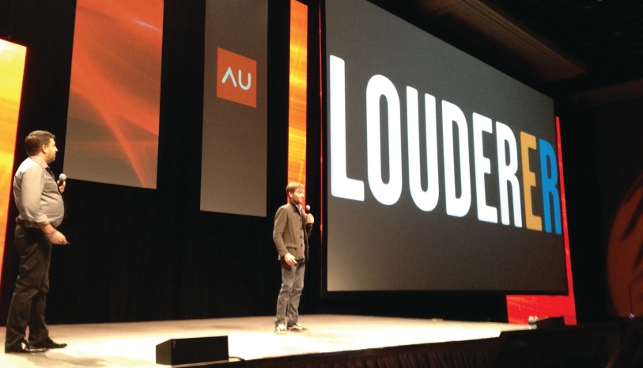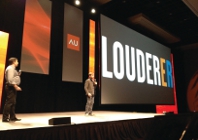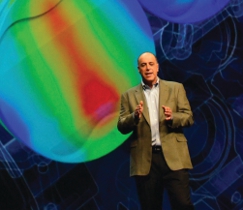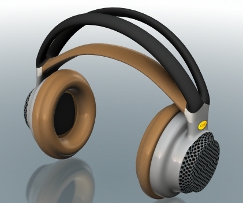Autodesk’s annual user bash is something to behold. Having been held in Las Vegas for the last five or six years, it always feels familiar to the regular visitors like myself and Martyn.

Jason Martin and Patrick Triato from Carbon Audio talk about their hyper accelerated product development
With that ever present bing-bing of a one-armed-bandit, the horrifically scented air conditioning and occasional late night induced mishap that’s part of the Vegas experience, Autodesk University (AU) is the one event at the very end of the software user conference calendar that’s hotly anticipated.
It’s in the Mandalay Bay hotel that we find out what Autodesk is doing, what its plans are for the year (and years) ahead and peek into what makes the company tick.
From the main-stage keynote presentations in front of 7,000 plus attendees, to more informal chats with company executives and troops on the ground, it’s here that you get a sense of where things are heading.
Autodesk is a much different company to the one it was when DEVELOP3D first attended AU.
Back then, both its mechanical design and architectural tools (Inventor and Revit) were nascent, recent entrants into the market. AU felt like an AutoCAD conference with a few bits tacked on the side to interest those with a passion for 3D design. Today’s event is radically different.
Both Inventor for product development and Revit for the architectural industries are the flagship products. This year I don’t recall AutoCAD getting a single mention in any of the keynotes, which reflects how the company has changed under the leadership of CEO, Carl Bass.
Bass is an alpha geek. In his Berkeley workshop, which I had the pleasure of visiting in early 2012, he uses many of the company’s products. Show me another CEO in this industry that has a four metre wide five-axis CNC router and I’ll be surprised. This passion for the creative has pervaded the company and its culture and shifted it dramatically.
Today’s Autodesk is not your father’s or grandfather’s Autodesk.
Fusion 360
For DEVELOP3D readers, perhaps the biggest news out of AU this year is the forthcoming Beta release of Fusion 360.
For those that haven’t been following it, Inventor Fusion has been Autodesk’s experiment with direct modelling over the last three years. In that time, it’s had several major releases on Autodesk Labs, been shipped with the Inventor Suites and the technology is now starting to pop up all over the place.
What Autodesk did a while back was rewrite it from scratch, so that it was a cross platform. Until now, that’s meant a Windows and Mac version being available.
However, it can now be delivered ‘on the cloud’ or more specifically, using cloud-connected services. If you’ve played with Project Simulus, there are portions of Fusion technology in there for pre-processing models for analysis and simulation.
But Fusion 360 is about much more than just pushing and pulling faces. It’s a new approach to how design and collaboration is conducted.
Looking at many of the existing CAD+Collab offerings, they’re often patched together with existing tools and stuck on a server. That’s a mistake. To take advantage of the benefits and potential you need something different to the existing tools “cloudified.”
At its heart, Fusion 360 is a platform that not only manages data, but also masks it from the user. It does this to place the focus on the project at hand.
This is done through threaded conversations, mark up and collaboration tools, all of which are readily accessible to anyone in the organisation. Everyone can chip in, bash out the problems and move a project forward. That’s what’s meant by social collaboration or social product development.
It’s all very interesting, but what really sets it apart, even at this early stage, is how the modelling technology (now with added T-Splines which Autodesk also acquired this year) is integrated into the whole thing. Rather than centring on the 3D data files, the user now works off a project.
To start modelling, the user simply opens the project and hits ‘New Design’. Not new part, not new assembly, but New Design. This kicks off a Fusion-based modelling session which is stored online.
It’s still very early days with Fusion 360, but it looks good and something that many organisations can find a use for.
In concert with what Autodesk is doing with cloud-based PLM, the whole thing starts to look cohesive and a good bet for the future. The cloud is coming and I suspect it’s going to come much quicker than many are predicting.
The maker’s mark
It’s clear that Autodesk has its eyes on the maker market.
But what is it? Some would say that it’s the tinkerer and hobbyist market, whilst others refer to it as a new breed of people that are interested in getting their hands dirty. I personally think it’s not something new, it’s just that the word “maker” has been hijacked to give it a new spin.
The only thing that seems new is access to some existing technologies (such as 3D printing, CNC machining etc.) and a lot more connectivity through the web. Why? Because the maker occasionally becomes the professional and while I’m sure Autodesk doesn’t or won’t object to the revenue generated by its 123D applications and Instructables.com, which it acquired this year, it gets mind share and that’s the key thing.
If Autodesk can build a relationship of trust with the hobbyist market, then when they graduate to doing this professionally, the tools get upgraded too.
Much of the talk at AU 2012 was about Making. There was a main-stage presentation from a 12-year-old maker who seemed more irritated by Makerbot’s call hours than playing outside.
There were also presentations from the likes of Mark Hatch of TechShop, one of a growing number of manufacturing and workshop collectives in the US, and Local Motors‘ CEO Jay Rogers spoke about crowd-sourced and self built kit cars.
However, the most interesting presentation of the event was hosted by Sarah Krasley, manufacturing program manager at Autodesk’s Sustainability Solutions.
She introduced Jason Martin and Patrick Triato from Carbon Audio, a Portland, Oregon-based company that’s been through a case study in how product development is changing.
Having pitched the idea for Zooka (a speaker system for iPads, MacBooks etc) on KickStarter, it managed to take its first product to market with $70,000 in funding in just seven months.
It’s worth noting that these aren’t tinkerers, these are industrial design professionals with an idea. But the accelerated speed with which these things can happen is something to watch evolve over the next few years.
Conclusion
AU is too large an event to really convey in a few written words and photos.
Instead I’ve tried to talk about how Autodesk is changing and how this is reflected in its key user event. What was interesting is that it seems to have grabbed hold of a couple of trends and run with them – think Makers and the cloud.
The first is slightly esoteric and left field for those in the professional industry, but things are brewing there that could influence how products are taken to market over the next few years.
Will the “maker revolution” affect the status quo for the majority? Probably not. But if you have an idea and want to pursue it, it does show that there’s potential to do things without the burden of traditional funding methods. And it can happen, as shown in Carbon Audio’s case, in a time-frame that’s never been seen before.
And then there are the cloud aspirations. What Autodesk is planning is bound to turn off some of the old guard, those that like their software in a box, in the post and a CD. Frankly, that’s not the target market.
Autodesk is building a next generation platform for the next generation of users. For the new recruits that have grown up in the internet age social collaboration will be key. After all, why not use the same approach that most are familiar with to benefit a professional or industrial task?
For many long time CAD pros, Autodesk means “The AutoCAD” company. But the things the company is doing now, the way it thinks and how it’s delivering its products now and in the future, I’ve a suspicion it will become known as the “Design Tool” company – both from the perspective of deliverables and attitude. And that is no bad thing. No bad thing at all. 
Autodesk University 2012 report from Las Vegas: Fusion360, Makers and more
Default









